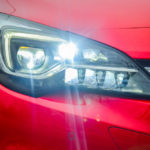Convertibles were once one of the most popular vehicles around. Their distinct and stylish appearance appealed to the masses, while the open-top design gave them a sporty yet glamorous look.
Not to mention you get the enjoyment of open-air driving, as it allows the occupants to feel the wind and sunshine while getting a better look at the scenic view. This made convertibles feel more immersive, as you rarely get to soak nature in during drives.
What Are Hardtop Convertibles?
Hardtop convertibles are a type of convertible car featuring a roof made of metal or composite panels. You can electronically retract and conceal the roof, transforming the vehicle from a closed coupe to an open-top convertible.
Convertibles were popular, especially during the 1950s and the 1960s. Unfortunately, the decline in popularity was imminent because of safety, security, and the increased pace of life.
Driving at 35 miles per hour isn’t the norm anymore. In fact, some highways have minimum speed limits based on the traffic flow. Plus, once you pick up speed in an open-top convertible, the gentle breeze won’t be as pleasant.
Some of the latest convertibles on the market today include:
- BMW 4 Series
- Ferrari 488 Spider
- Ferrari Portofino
- McLaren 570S Spider
- Mazda MX-5 Miata RF
- Mercedes-Benz SL-Class
- Mercedes-Benz SLC-Class
Hardtop vs. Soft Top Convertibles

Convertibles have two types of roofs based on top material: Hardtop and soft top. Hardtops use metal or composite panels, while soft tops have a fabric roof, making them lighter than their hardtop counterparts.
Pros of Hardtop Convertibles
Hardtop convertibles are not only sleek-looking, but they’re also safe and secure, provide better noise control, have enhanced weather resistance, and are easy to clean.
Safe and Secure
Compared to soft top convertibles, hardtops are the safer option. This applies to both security and road safety.
Because these cars have roofs made from solid materials, they’re harder to break into than soft top roofs, which could be slashed or cut open.
You’re also safer on the road with a solid roof over your head. You have a better chance of leaving rollover accidents relatively unscathed because the roof will absorb some of the impact.
Better Noise Control
The solid material of hardtop roofs significantly reduces road noise when the roof is unfolded. It’s more apparent during heavy rain, as the raindrops don’t produce a loud sound when they hit metal compared to the pitter-patter noise when hitting fabric tops.
Enhanced Weather Resistance
Speaking of the weather, hardtops are generally more resistant to the elements. The roof’s thicker material helps keep cold, heat, and moisture out, especially compared to the thinner roofs of soft top convertibles.
Easy to Clean
Hardtops are a breeze clean because their roofs are made of metal, the same material used for the body. Cleaning them doesn’t require as much work compared to maintaining soft tops.
The only thing you have to be wary of are the seals, as dirt and debris could build up in them. Make sure to clean them thoroughly to prevent corrosion.
Soft tops, on the other hand, are more difficult to clean. You’ll have to use a microfiber wash mitt and a specialized cleaning solution to avoid damaging the soft fabric and the vehicle’s paint job.

Cons of Hardtop Convertibles
Of course, hardtops also come with disadvantages. Some glaring ones include how heavy they are, the lack of space, and the steep price point of buying and owning one.
Heavy
Because of the roof’s material, hardtop convertibles are generally heavier than soft tops. This means they can’t change directions as quickly as soft tops due to momentum. In addition, it also has decreased fuel economy due to the weight.
Hardtops also have a longer braking distance and a harder time accelerating. This could be dangerous if you’re not used to it because there’s a higher risk of crashing with the vehicle in front of you.
Less Space
The roof of hardtops has to go somewhere when it’s folded. Unfortunately, it goes straight into the trunk, decreasing cargo space.
This means you’ll likely have to keep the roof unfolded if you want to use the trunk for your baggage during road trips. That slightly defeats the purpose of a foldable roof meant for drivers to enjoy scenic views.
Expensive
Hardtop convertibles are more expensive than soft tops because of the complex folding mechanism. In addition, they cost more to maintain because of the sensors and electronic parts that come with the foldable roof.
They’re also expensive to insure because of the high price point and the increased risk of theft and vandalism due to their slick and appealing style.
Best Hardtop Convertibles
If you’re looking for an affordable hardtop convertible, here are some of the best ones available:
These cars offer great performance on top of their sleek and modern design. This list shows how versatile convertibles are. You have a high-performing sports car in the Mazda MX-5 Miata RF and superb off-roading potential with the remaining three SUVs.
The Bottomline
Hardtop convertibles feature a metal roof you can electronically retract to transform the car from a closed coupe to an open-top convertible. Because of this, they (along with soft tops) were once the most popular vehicle in America, especially during the 60s.
The key difference between the two is the material used for their roofs, as soft tops used fabric for theirs. Some advantages of hardtops include better security, superior noise control, and enhanced weather resistance.
Any information provided on this Website is for informational purposes only and is not intended to replace consultation with a professional mechanic. The accuracy and timeliness of the information may change from the time of publication.



















Some soft top convertibles are cloth rather than vinyl. Those cloth tops should be sprayed occasionally with a water sealer similar to some raincoats! IE: 93 Corvette 40th anniversary convertible or 2004 Thunderbird convertible